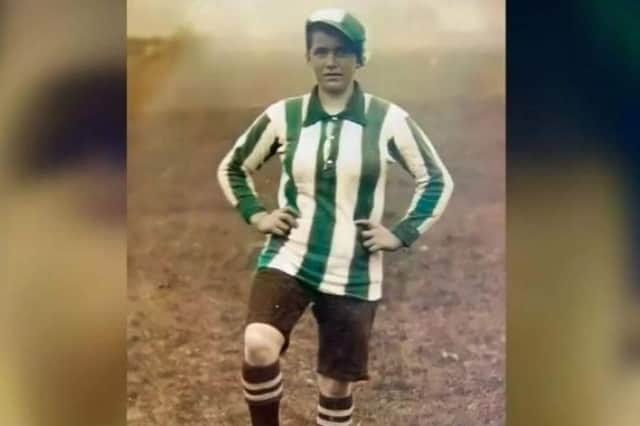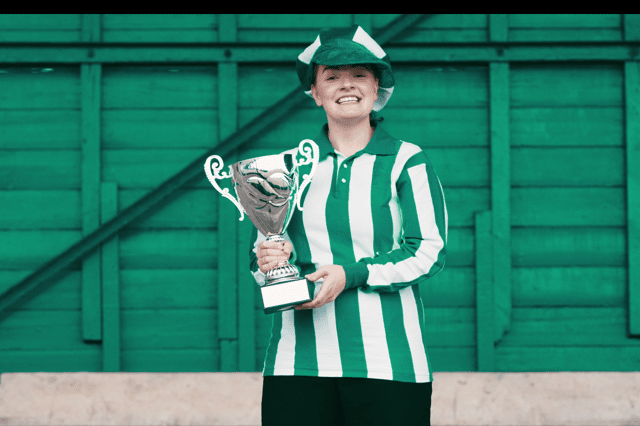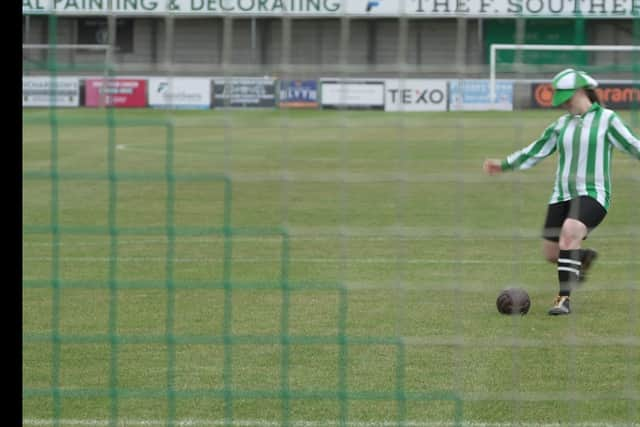When Sunderland was a hotbed of women's football while the First World War raged on
and live on Freeview channel 276


During the First World War, Sunderland was a hotbed of women's football.
Ahead of his ‘Wor Bella’ play coming to the region, playwright Ed Waugh explains how female munitions workers - ‘munitionettes’ - on Wearside raised money for wartime charities playing the beautiful game.
Advertisement
Hide AdAdvertisement
Hide AdThe slaughter of more than 750,000 men at Ypres and Passchendaele meant male conscription was introduced in 1916 and millions of women moved into the workplace to save the war effort.
These heroic women not only worked a 60-hour week in dangerous conditions but hundreds found time to play football in their work breaks.
With men's professional football being banned from 1915, a vacuum for entertainment opened up and it was filled by the football-playing munitionettes, who raised money for wartime charities.
Matches were played on local grounds and many thousands turned up to watch.
Advertisement
Hide AdAdvertisement
Hide AdIn Sunderland, there were three main teams: Webster & Co, a rope-making company based in Ropery Walk, Deptford; Glaholm, Robson & Co, a wire rope-making company from Hendon; and Sunderland Ladies.
With no leagues, what made football in the North East so unique was a trophy donated by Sunderland businessman Alfred Wood, a partner in Hartley Wood & Co, a glass company based in Deptford.
This became known as the Munitionettes cup and was open to teams from throughout our region.
Ironically, (for some unknown reason) no Sunderland team entered the 1918 or 1919 competitions that were won by Blyth Spartans Ladies and Palmers (Jarrow) respectively.


Advertisement
Hide AdAdvertisement
Hide AdHowever, the three Sunderland teams had a busy fixture list. Sadly, facts are sketchy.
The earliest record we have is of a Sunderland Ladies' practice match at Holmes' Field, which was in Fulwell Dene.
On November 17, 1917, Glaholm & Robson burst onto the scene with a 4-0 victory over Hood Haggie's of Wallsend. Their next match, on November 24, was a derby against the debutants of Webster Munitionettes.
The 1-1 draw was played out at High Barnes. On December 1, 1917, Sunderland Ladies then took on the mighty Blyth Spartans Ladies at Hendon and lost 5-0. Another defeat hit them a week later when they lost 1-0 to Webster in a derby return match.
Advertisement
Hide AdAdvertisement
Hide AdThe Christmas run-up saw Wearside Girls take on Teesside Girls on December 22, 1917, at Hendon, the ground of Sunderland Rovers. At composite team, comprising players from G&R, Sunderland Ladies and Webster, lost 4-2.
It seems snow delayed matches at the end of 1917 and at the restart on January 2, 1918, Sunderland Ladies were hammered 10-0 by Blyth Spartans Ladies in front of 5,000 people at Croft Park, Blyth.
On February 2, Newcastle Ladies beat Sunderland Ladies 2-1 at Southwick (location unknown) in front of 2,000 people.
The score lines are irrelevant, the growing crowd numbers shows how women's football on Wearside was mushrooming in stature. On February 2, a fortnight later, Webster defeated G&R 2-1 at Sunderland Rover's ground in Hendon.
Advertisement
Hide AdAdvertisement
Hide Ad"Several thousand" were in attendance. In March 1918, G&R played out a 1-1 draw with Armstrong Whitworth No. 58 Shop at Ashbrooke. Sadly, no attendance figure was recorded.
In April, all three Sunderland teams were in action, coming up against Houghton Munitions Workers, Hebburn Ladies (lead works), Hood Haggie's Munitionettes (Wallsend), Browns (Hartlepool) and Palmers (Jarrow). Given the geographical locations of the opponents, it can be seen how the influence of women's football was growing throughout the region.
In May, Wearside Munitionettes visited Teesside Munitionettes. Despite a 4-0 defeat, the better players were now in composite teams, playing against the best in the region, which included players from workplaces in Darlington, Middlesbrough and Hartlepool.
Still in May, we find the only recorded game played by Craven & Speed Ropery, based in Monkwearmouth.
Advertisement
Hide AdAdvertisement
Hide AdTheir 3-0 defeat by Angus Sanderson appears to be their one and only bow. Later this month Sunderland Ladies drew with Murton ladies 2-2 at Murton while Webster drew 0-0 with Browns of Hartlepool at Seaham. In June, Minnie Seed played for a North of England side against a Tyneside Internationals team against at St James' Park, Newcastle. It ended in a 2-2 draw.
Not to be outdone by the fairer sex, a "men versus women" match took place at Ryhope.
The Lady Munitions Workers ran out 5-4 winners over the men's team, Ryhope Villa. Girl power! During this 18-month period, quality teams emerged as well as skillful and exciting individual players.
The likes of Bella Reay (Blyth Spartans), Mary Lyons (Jarrow), Minnie Seed (Sunderland) and Winnie McKenna (Middlesbrough) emerged as top-class footballers, going on to represent regional and England teams.
Advertisement
Hide AdAdvertisement
Hide AdMinne Seed played for Sunderland Ladies as well as the top teams in the region, and for England representative sides.
The truce to end WWI was called in November 1918 and most of the munitionettes were immediately made redundant - discarded; paving the way for the men returning home from war to take up employment. Women's football may have limped on after the armistice but it was still hugely popular.


In November 1918, G&R played Foster, Blackett & Wilson (Jarrow) at Ashbrooke, reportedly in front of a "very large crowd". May 1919 seems to be the final hurrah for Sunderland women's football when Roker Park hosted 10,000 spectators to witness Sunderland Munitionettes lose 4-1 to Newcastle Munitionettes.
Throughout the halcyon days of North East WW1 women's football, Blyth Spartans Ladies were the undefeated champions, playing 30 matches winning 26 and drawing four . Blyth won the Alfred Wood ("Muntionettes") cup 1918.
Advertisement
Hide AdAdvertisement
Hide AdThat final at St James Park attracted 18,000 people and the replay at Ayresome Park saw 22,000 in attendance.
Jarrow Palmers won the cup in March 1919, by which point most men had been de-mobbed and the armaments workplaces had turned into "peacetime" industries.
These working class munitionettes created real history but rarely spoke of it afterwards; their sacrifice and dedication went unrecorded...forgotten, a mere footnote in history.
A disgraceful situation. There are few, if any, memorials to these selfless munitionettes. To rub salt into the proverbial wounds, the vast majority of these women who had saved the war effort were not even eligible to vote in the December 1918 election because they were under 30 and didn't have property rights - they'd have to wait until the 1929 election when women over 21 were granted the vote.
Advertisement
Hide AdAdvertisement
Hide AdAnd - and this is unforgiveable - women's football was banned by the FA in December 1921. It came after the miners' strike of that year when a number of teams were reformed to raise money for striking miners and their families.
The unelected, predominantly privileged FA management decided women's football was too political. Women's football was only unbanned in 1971 - 50 years later; a time of the women's liberation movement.
- Wor Bella is the stage play of these heroic WWI munitionette footballers. After a hugely successful tour in April 2022, Wor Bella transfers to The Bread and Roses Theatre in Clapham, London (April 22 to 24) and Newcastle Theatre Royal (April 27 and 28).
Seen through the eyes of Bella Reay, who scored an incredible 133 goals in 30 games for Blyth Spartans Ladies between 1917 and 1918, Wor Bella stars Chester le Street actress Catherine Dryden as Bella Reay. For more details visit www.worbella.co.uk
Comment Guidelines
National World encourages reader discussion on our stories. User feedback, insights and back-and-forth exchanges add a rich layer of context to reporting. Please review our Community Guidelines before commenting.